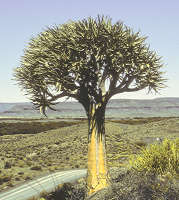 |
Aloe aculeata Pole-Evans 1915 (Red Hot Poker Aloe)
The large rosettes are formed from light-green succulent leaves, spotted with distinctive white pustules and reddish prickles, especially on their lower surface. Leaf edges have many small sharp reddish teeth. The branched inflorescence has up to four dense cylindrical racemes of yellow flowers.
Native to hot, dry mountains of Zimbabwe.
|
 |
Aloe acutissima Perrier 1926
Name: Latin = very acutely pointed
A low-growing sprawling Aloe whose recurved blue-green leaves with toothed margins, colour up violet to bronze in strong light. The inflorescence is a raceme of tubular orange-red flowers.
Native to Madagascar.
|
 |
Aloe affinis Berger 1908
Name: Latin affinis = "related to, resembling" (other spotted Aloes)
This Aloe is stemless or with a very short stem. The tapering yellowish-green succulent leaves have longitudinal lines or spots and reddish-brown marginal teeth. The 3ft inflorescence is branched with 5 - 10 cylindrical racemes of dull-red tubular flowers with swollen bases and exserted stamens.
Native to sandstone mountains (3000 - 5000ft) of the South African Mpumalanga (Eastern Transvaal), a warm Summer rainfall area with light frosts in Winter.
|
|
Aloe africana Miller 1768 (Uitenhaagsaalwyn)
This medium-sized solitary plant grows up to 6ft tall. The gray-green lanceolate succulent leaves have small, sharp reddish-brown marginal teeth. Dead leaves persist on the lower stem. The solitary or branched inflorescence produced in early Spring, is a dense raceme of tubular yellow flowers distinctively curving upwards and with exserted orange stamens. Flowers are followed by dehiscent capsules containing winged seeds.
Aloe africana is native to the coastal Eastern Cape of South Africa especially around Uitenhage and Port Elizabeth, where it experiences rainfall throughout the year. The flowers are attractive to sunbirds.
|
 
 |
Aloe arborescens Miller 1768 Syn: A. mutabilis (Krantz Aloe, Kransaalwyn)
This medium-sized shrubby, branching Aloe grows to 6 ft, with large, decorative spikes of yellow, orange or red tubular flowers. Bicoloured forms are also known. More than one of the unbranched inflorescences can be produced from each rosette. In strong light the bluntly-toothed leaves take on a grey-green colour.
Aloe arborescens is widely distributed through the Eastern Summer rainfall regions of South Africa, Mozambique, Malawi and Zimbabwe and grows from sea level to the tops of mountains, often growing on exposed rocky ridges (= krantz).
Aloe arborescens is widely-cultivated in tropical countries, as a garden ornamental plant, for hedging and for the healing properties of the gel within its succulent leaves. Propagation from stem cuttings is easy.
Left: A variegated form of Aloe arborescens.
See also the natural hybrid: Aloe principis |
 |
Aloe arenicola Reynolds 1938 (Sand Aloe, Sand-Aalwyn)
Name: Latin areni + cola = "sand dweller" referring to its habitat.
This distinctive Aloe has small, fleshy triangular succulent leaves with prominent white tubercles on their outer (lower) surface. Small plants may form a rosette but soon lean over and adopt a trailing habit. Leaf margins may have teeth or raised tubercles. The stems offset at their base to form large clumps. The inflorescence is a head of tubular orange-red flowers with greenish-yellow tips, hanging down as the flowers open.
Native to sandy soils of the coastal Northern & Western Cape where it experiences Winter rainfall and fogs at other times.
|


Photo: David Mostardi |
Aristaloe aristata (Haworth) Boatwright & Manning 2014
Syn. Tulista aristata (Haworth) G.D. Rowley 2013
Syn. Aloe aristata Haworth 1825 (Torch Aloe)
from South Africa forms a small stemless 6-8 in rosette. The triangular soft green succulent leaves have raised white spots, especially on their undersides, finely toothed edges and filamentous tips. The rosettes offset freely and with time will form a substantial clump. Offsets may be removed and used for propagation.
Aloe aristata is often grown indoors as a window-ledge succulent plant, but it is very hardy. In the Drakensberg mountains it grows at up to 7500 ft and is equally happy growing outside through the wet English winter, provided that it is potted up in a very free-draining medium. It does well on a sunny patio, potted up in almost pure granite chippings mixed with a small amount of soil.

Left: During the summer Aloe aristata flowers freely, with 10 in spikes of tubular pink flowers attracting bees and other insects.
Right: A top layer of snow is no problem. This large clump of Aloe aristata in a shallow planter has been under snow many times. |
|
Aloidendron barberae (Dyer) Klopper & Gideon F.Sm. 2013
Syn. Aloe barberae Dyer 1874, A. bainesii Dyer 1874
This tree Aloe can grow over 50 ft tall. Its stout trunk is covered with grey bark and branches dichotomously once it reaches about 10 ft to form a rounded crown of many rosettes. The dark green recurved succulent leaves forming each rosette have raised edges with small teeth.
The infloresence is a short raceme of densely-packed tubular reddish flowers with exserted yellow stamens.
Widely distributed across Southern East Africa from the Cape to Mozambique. This is the type species for the new genus Aloidendron.
|

 |
Aloe bellatula Reynolds 1956
is a choice, tender plant from Madagascar, growing at elevations of around 4500 ft. The 10in long thin succulent leaves are marbled brown and green, becoming bronzed in strong light. Tiny, pale teeth along the leaf margins make them feel rough rather than sharp. The rosettes offset freely at their base to form a dense clump. The inflorescence consists of a raceme of delicate pink and darker pink striped bells on the end of a long stalk. This plant is easy to grow on a sunny window-ledge. In England it flowers freely in mid-December.
|
Aloe albiflora Guillaumin 1940
is a very similar plant to Aloe bellatula but with pure white flowers. Native to Madagascar. |
 |
Aloe brevifolia Miller 1771 Syn. A. perfoliata, A. prolifera
The compact 5in rosettes offset to form dense clumps. The triangular succulent leaves have teeth on their margins and sometimes on their surface. The inflorescence is a raceme of tubular orange flowers.
Native to the Western Cape of South Africa. Undemanding in cultivation.
|
 |
Aloe buhrii Lavranos 1971
The rosettes are formed from 12-15in lanceolate leaves with narrow longitudinal lines. As the succulent leaves mature they become purplish and marked with white spots. The multi-branched inflorescence has racemes of orange to yellow flowers.
Native to a restricted range in the mountains of the Western Karoo of South Africa.
|
|
Aloe bulbillifera H. Perrier 1926
Name: Latin bulbilla = bulbils
This medium-sized Aloe forms a stemless or short-stemmed rosette from dull green lanceolate leaves with small green marginal teeth. A long flower stalk terminates in a branching inflorescence of tubular orange flowers with greenish tips. After flowering, small bulbils form along the flower stem.
Native to Madagascar.
|
 Photo: Marissa Lilly 2018
Aloe cooperi Baker 1874 (Cooper's Aloe)
Named for: Thomas Cooper (1815-1913) English botanist at Kew & explorer in South Africa.
Stemless or short-stemmed plants produce a fan of long, narrow yellowish-green v-shaped leaves, which may have a few white spots near their base and tiny white marginal teeth. A dense cluster of tubular orange flowers with a narrow greenish tip is produced at the end of a long flower stalk.
Native to dry grasslands and marshes of Southern Africa including Mozambique, Swaziland and South Africa. Young shoots and flowers are cooked and eaten by Zulus. An infusion of the flowers contains anthraquinones and is used as a laxative and to ease childbirth. This Aloe is used in dry landscaping and the flowers are attractive to nectar feeders such as sunbirds. It is frost tolerant.
|
 |
A. cryptopoda Baker 1884 Syn. Aloe wickensii (Geelaalwyn)
from Southern Africa including Mozambique, Swaziland and Mpumalanga has long tapering bluish-grey succulent leaves, colouring up with a purple hue in bright light. Leaves have brown marginal teeth. The inflorescence is a branched spike of orange-red or yellow tubular flowers or flowers with orange-red buds opening yellow.
Natural hybridization has been reported, which may contribute to the variable flower colour of this species. Its habitat range is a Summer rainfall area.
|

|
Aloe deltoideodonta var. candicans Perrier 1926
is a medium-sized plant, growing at 2000 - 2500 ft in the mountains of central-southern Madagascar. The stemless rosettes of triangular pale green leaves (up to 6 in long) with prominent longitudinal darker green lines and finely toothed margins, spread by offsetting from the base to form loose clusters. The inflorescence bears a cluster of salmon-pink tubular flowers.
Left: Desert Botanical Garden, Phoenix, Az., Sept. 2004.
Aloe deltoideodonta var. deltoideodonta Reynolds 1966 - darker green leaves with variable amounts of broken white lines or spots.
Aloe deltoideodonta var. brevifolia as var. deltoideodonta Perrier 1926 - but rather shorter more triangular leaves.
|
 |
Aloidendron dichotomum (Masson) Klopper & Gideon F.Sm. 2013
Syn. Aloe dichotoma Masson 1776 (Quiver Tree, Kokerboom)
is a distinctive tree Aloe from dry rocky areas of the Western Cape and Namibia. The common name refers to the traditional use of hollowed stems of this tree as quivers. This is one of the largest species of Aloe, growing up to 30 ft tall.
A single trunk divides into numerous branches at the top, each branch bearing a rosette of narrow grey-green succulent leaves. Old leaves are not retained on the smooth, but ridged trunk with sharp edges to each scale. The inflorescence is divided into three to five racemes of large tubular yellow flowers. In a young plant the leaves are arranged in vertical rows and only with maturity, spiral to form a rosette.
Left: North Escarpment near Nieuwoudtville, RSA. December 1998.
More pictures of Aloe dichotoma
|
 |
Aloe dorotheae Berger 1908
is an attractive medium-growing species from Tanzania. The succulent rosettes are bright green in average light but develop a coppery-red hue in full sun. The shiny leaf surface is marked with scattered white spots and the leaf margins have prominent teeth. The rosettes offset freely by suckering to form dense clumps. The unbranched inflorescence carries clusters of glossy bright red tubular flowers. This is an attractive ground-cover plant for frost-free xeriscaping.
Left: Desert Botanical Garden, Phoenix, Az., Sept. 2004. |
 
|
Aloe ellenbeckii Berger 1905 Syn. Aloe dumetorum Mathew & Brandham 1990
The rosettes have fleshy thick green succulent leaves with rows of pale green spots, sometimes elongated into streaks. The leaf margins are furnished to a variable extent with small triangular white teeth. The plants clump up freely by offsetting at their base and the leaves may become bronzed in strong light. The inflorescence is a raceme of orange flowers with pale yellow-green tips on the end of a 1ft stalk, usually produced in the Autumn. The tubular flowers have swollen bases.
Native to Ethiopia, Somalia and Kenya. Undemanding in cultivation.
|

|
Aloe excelsa Berger 1906 (Noble Aloe)
from Zimbabawe, Zambia, South Africa and Mozambique is a tree Aloe with a solitary stem up to 14 ft, bearing a large rosette of 3ft dark green sword-shaped succulent leaves with reddish-brown marginal teeth. The leaf surfaces are thorny, especially those of younger plants. Old leaves remain attached to the stem, providing protective felting. The branched candelabra-like inflorescence carries 10 - 15 racemes of orange to crimson flowers.
Aloe excelsa is an impressive plant, widely used in landscaping. It grows at up to 2500 - 5000 ft and receives mainly Summer rainfall and a cool, dry Winter. Traditional use is made of antimicrobial substances in the leaves and as a treatment for a variety of digestive disorders and diabetes.
|
 |
Aloe falcata Baker 1880 (Vans Rhynsdorp Aloe)
growing near Vans Rhynsdorp, South Africa, December 1998. The smooth blue-green succulent leaves have sharp brownish teeth along their margins and form compact rosettes which often lie at an angle. Aloe falcata flowers in December - January, mid summer in the Southern hemisphere and the hottest time of the year. The branched inflorescence carries spikes of tubular orange flowers.
This species comes from a winter rainfall area in the North-Western Cape and should be watered carefully and hardly at all during the summer flowering season when it would usually be completely dry. It requires water during the winter which may be a problem in cool climates.
|
 |
Aloe ferox Miller 1768 (Cape Aloe, Bitter Aloe, Bitteraalwyn, Bergaalwyn)
is a tall, single stemmed Aloe up to 10 ft tall with a wide distribution in the South African Cape, Southern KwaZulu-Natal, Lesotho and the Free State, in grassland and bush in both Summer and Winter rainfall areas.
The large 3ft, tapering, fleshy, grey-green succulent leaves with reddish-brown toothed margins are arranged in a dense rosette. Teeth may be present on the leaf surfaces, especially in immature plants. Old leaves remain as protective felting on the stem, leading to a rather untidy appearance.
Left: Aloe ferox flowering at the Kokerboomkwekery, Van Rhynsdorp. Xmas 1998.
More pictures of Aloe ferox
See also the natural hybrid: Aloe principis
|
The flowers in various shades of orange are carried well above the leaves on candelabra-like heads with up to ten dense flower spikes. Copious production of nectar makes the flowers attractive to birds, insects and monkeys.
Aloe ferox is an impressive feature plant for a Mediterranean climate, or as a container plant if it can be given Winter protection. However it is grown, it needs full sun and free-draining soil to prosper. This species hybridizes freely with other Aloes.
Aloe ferox is the source of "Bitter Aloes," the yellow juice from just under the skin, which is a powerful purgative. The gel within the middle of the succulent leaves has similar soothing properties to that of A. vera.
|
|
Aloe forbesii Balfour 1903
The short, branching stem becomes prostrate on the ground with the dark-green rosettes clumping up to form a mat. Rosettes are composed of
long (10 in), narrow dull green succulent leaves with brownish marginal teeth. The inflorescence is a short, open raceme of orange flowers with greenish-yellow tips. Immature flower buds are yellow and become more orange as the flowers develop.
Native to Socotra.
|
|
Aloe helenae Danguy 1929 (Vaombe )
This tree Aloe grows up to 20ft tall, with a relatively slender trunk supporting a heavy crown of shiny, dark green leaves. A mature specimen may offset lower down the trunk. The succulent leaves are deeply channelled and recurved and have many tiny reddish teeth along their margins. The inflorescence is a dense raceme of yellow buds becoming more orange toward the top of the cluster, opening to tubular yellow flowers with exserted stamens.
Native to Southern Madagascar where it is critically endangered. Uncommon in cultivation and photographed in flower at RBG Kew.
|
 |
Aloe juvenna Brandham & S Carter 1979
from Kenya has small rosettes of triangular green succulent leaves bearing white spots, some raised, or streaks and prominent inward-curving marginal teeth. The rosettes turn reddish-brown in full sun. Old leaves remain green, so as the stem elongates a characteristic densely-stacked rosette forms. Stems offset at their base or occasionally higher up to form a dense clump. The unbranched inflorescence carries a cluster of tubular red flowers.
A tolerant succulent plant for any window-ledge, but dislikes being watered during its winter resting period. Often confused with Aloe squarrosa.
Photo: Jim Myers
|
 |
Aloe lateritia Engler 1895
This Aloe has dense stemless rosettes of dark green succulent leaves, with fine marginal red teeth and patterned with elongated pale spots. The leaves take on a red colour in string light and their tips tend to wither. Plants may form clumps by suckering. The inflorescence is a dense panicle of yellow to orange flowers.
Native to grassland of Kenya, Ethiopea and Tanzania. The leaves are applied to various skin lesions and a decoction of the leaves is a traditional remedy for fevers and for treating livestock. The roots yield a yellow to pink-brown dye.
|
 |
Aloe leptosyphon Berger 1905 Syn. Aloe greenwayi Reynolds 1964
The rosettes of green lanceolate succulent leaves have either no stem or a very short one. Leaf margins have small teeth and their upper surface may have a few elongated white spots. The inflorescence is a cylindrical raceme of tubular orange-red flowers with yellow-green mouths.
Native to Tanzania.
|
 |
Aloe microstigma Salm-Dyck 1854
is widely distributed across the dry interior of the Western to Eastern Cape Province. The medium-sized blue-green rosettes turn bronze and curl inwards in full sun or when stressed, thus protecting the inner rosette. The succulent leaves are speckled with white spots and their margins have prominent brown teeth.
This species flowers freely through the winter with dense spikes of tubular orange flowers turning yellow as they open. The nectar from these is attractive to birds which are the main pollinators. A suitable plant for frost-free dry gardens.
|
  |
Aloe millotii Reynolds 1955
This dwarf Aloe forms a mat of procumbent stems crowned with a suculent rosette of 8 - 10 lanceolate leaves that become channelled and recurved in response to drought. The upper green leaf surface is speckled with white spots or streaks and has small white marginal teeth. Leaves become reddened in full sun. The inflorescence is a cluster of yellowish orange tubular flowers.
Native to limestone soils at the Southern tip of Madagascar.
|
 |
Aloe mitriformis Miller 1768 Syn. A. perfoliata (Mitre Aloe, puin aalwyn, krans aalwyn)
The long creeping stems, often with side shoots, terminate in a rosette of triangular bluish-green succulent leaves with yellowish marginal teeth and pustulate undersides. The branched flower stalks produce up to five dense racemes of tubular dull-red flowers during the Summer.
Widely distributed in mountains of the Western Cape of South Africa where it experiences mainly Winter rainfall.
|
  |
Aloe peckii Bally & Verdoorn 1956
grows on gypsum soils in Somalia at elevations of around 5000 ft. The stemless olive-green rosettes have fleshy, usually streaked or banded succulent leaves (6 in) whose margins bear sharp brown teeth. The branched inflorescence has spikes of small straw-coloured to greenish-yellow flowers, with paler petal borders
causing a striped appearance.
The flowers distinguish this species from the similar A. somaliensis which has pink to red flowers.
Left: Desert Botanical Garden, Phoenix, Az., Sept. 2004.
|
 |
Aloe pendens Forsskål 1775
from the Yemen has a lax speading habit making it suitable as a ground-cover or hanging-basket plant. In its habitat it grows down rock faces.
The narrow floppy succulent leaves have small white spots and toothed edges. The stems offset freely at their base. The thin flower stalk bends down and then upwards to display a spike of yellow or orange-red tubular flowers. Flowers are produced throughout the year.
|
|
Aloe penduliflora (Taita Aloe) Baker 1888
A slender stem up to 6ft tall supports a rosette of lanceolate fleshy leaves with toothed margins.
Flowers may be yellow or red as in this specimen and are supported on a drooping flower stem. Their copious production of nectar makes them attractive to hummingbirds.
Native to rocky slopes of mountains of South-Eastern Kenya. Collected for medicinal use and endangered.
Seen here at RBG Kew.
|
 |
Aloe petricola Pole-Evans 1917
Name: petri = "stone" + cola = "fond of" referring to its ocurrence among stones
This Aloe is stemless and the rosette remains solitary. The glaucous green succulent leaves have a few prickles on their upper surface and dark brown marginal teeth. The lower surface is obtuse with a line of prickles along the upper portion of the keel. The branched inflorescence has 3 - 6 cylindrical distinctive bi-coloured racemes of, greenish white at the bottom to pale orange near the top, tubular flowers with dark brown anthers.
Native to sandstone and granite mountains in a small area near Nelspruit, Mpumalanga (Eastern Transvaal), South Africa. Similar to Aloe aculeata but with fewer thorns, especially on its lower surface.
|

|
Aloidendron pillansii (Guthrie) Klopper & Gideon F.Sm. 2013
Syn. Aloe pillansii Guthrie 1928 (Giant Quiver Tree, Reusekokerboom)
Named for: N.S. Pillans, South African botanist.
This distinctive tree Aloe has a stout trunk with rough, greyish bark. The trunk may produce several upright branches with age, each of which carries a large terminal rosette of greyish green succulent leaves, whose margins have small white teeth. The branched inflorescence arises horizontally among the lower leaves of the rosette and carries several racemes of slightly-swollen yellow flowers.
Native to the North-Western Cape into Namibia.
|

Kirstenbosch Botanic Garden, RSA. December 1998.
 
RBG Kew.
Kumara plicatilis (Linnaeus) Klopper & Gideon F.Sm. 2013
Aloe plicatilis (Linnaeus) Miller 1768 (Fan Aloe, Bergaalwyn, Tongaalwyn, Franschoekaalwyn)
Name: Latin plicatilis = fan-like, pleated, folding together
This Aloe has a limited distribution in the mountains of the South-Western Cape, a winter rainfall area. This distinctive Aloe is is popular with collectors, although it is slow-growing and in a temperate climate is sensitive to watering. Large specimens may grow up to 15 ft tall in their native habitat but 6 - 8 ft tall would be exceptional in cultivation.
The grey-brown stems are forked dicotomously, with clusters of strap-shaped blue-green succulent leaves arranged in two opposite rows on the end of each stem. The 10 in leaves have a few small teeth distal to the stem. The fan-shaped arrangement of leaves is unique to this species. Each leaf cluster can produce a single cylindrical raceme of tubular scarlet flowers towards the end of the winter.
|

Photo: RJ Hodgkiss

Photo: Mike Kaplan
|
Aloe polyphylla Schönland ex Pillans (Spiral Aloe, Kroonaalwyn)
 grows at 6000-8000 ft in the Drakensberg mountains, where it sometimes experiences winter snow. Even during the summer, rain is frequent. This is one of the few Aloes that may withstand the constant wet, frost and snow of the English winter, provided that it is growing in very free-draining soil. It is more likely to suffer during over-hot summers.
grows at 6000-8000 ft in the Drakensberg mountains, where it sometimes experiences winter snow. Even during the summer, rain is frequent. This is one of the few Aloes that may withstand the constant wet, frost and snow of the English winter, provided that it is growing in very free-draining soil. It is more likely to suffer during over-hot summers.
In its habitat, Aloe polyphylla grows among loose basalt rocks and in rock crevices so potting it up in a medium containing a high proportion of granite chippings is not inappropriate for a damp climate.
In a mature Aloe polyphylla over 8 in and up to 18 in in diameter, the grey-green succulent leaves are ranked as five rows in a spiral, which, as shown in these two pictures, may be either left or right-handed. The leaf magins carry a few small teeth. The sharp leaf tips, tend to go brown.
The plants are stemless and do not offset, so propagation must be from seed. The branched inflorescence carries clusters of orange to reddish tubular flowers which are self-sterile and cross-pollinated in their habitat by sunbirds. This species is listed as endangered, partly due to collection. However, plants grown from seed or from micro-propagation are becoming freely available and do well in cultivation.
|


Photos: Jorge Cannas, 2013
|
Aloe x principis Stearn 1938 Syn. Aloe salm-dyckiana
Name: Latin princeps = a prince or chief
This tree Aloe is a natural hybrid: Aloe arborescens x Aloe ferox.
Aloe x principis grows up to 8 ft tall with a sparsely-branching main trunk bearing large rosettes of succulent gray-green leaves with small marginal teeth. The branching inflorescence carries several dense spikes of tubular scarlet to orange flowers, in some clones turning yellow as they open.
Occurs naturally in parts of South Africa where A. arborescens and A. ferox grow together. In such places a range of growth habits and flower colours are seen, from which plants in cultivation have been selected.
|

|
Aloe pseudorubroviolaceae Lavranos & Collenette 2000 (Arabian Aloe)
forms clumps of large 2 ft diameter rosettes of smooth, thick, blue-grey succulent leaves with toothed margins. In very strong light or when stressed by drought, the leaves may take on a pinkish hue (hence pseudorubroviolaceae). The branched inflorescence of waxy orange-red tubular flowers is produced in winter.
This succulent plant grows on steep slopes above 6000 ft in Yemen and Saudi-Arabia and is reported as tolerating light frost providing that it is grown in full sun in very well-drained soil.
|
|
 Aloe purpurea Lamark 1783 Aloe purpurea Lamark 1783
See Syn. Lomatophyllum purpureum (Lamark) T.Durand & Schinz 1894
|
|
Aloidendron ramosissimum (Pillans) Klopper & Gideon F.Sm. 2013
Syn. Aloe ramosissima Pillans 1937 (Maiden's Quiver Tree, Nooienskokerboom)
Name: ramosissima = very much branched
The dichotomously-branching, smooth stems of Aloe ramosissima carry a head of upwardly-curving, lanceolate grey-green leaves. These succulent leaves have a flat upper surface, rounded cross section and tiny browish marginal teeth along the narrow, yellowish upper leaf margin. The inflorescence is a short raceme of swollen tubular yellow flowers close to the foliage.
This shrubby succulent plant is native to hot dry mountains of the Northern Cape and Southern Namibia. Aloe ramosissima is distinguished from A. dichotoma by absence of a trunk, hence the synonym: A. dichotoma var. ramosissima Glen & Hardy 2000.
|
 |
 |
Aloe reynoldsii Letty 1934
from the Eastern Cape of South Africa is a low-growing rosetted succulent plant, clumping with maturity. The waxy, blue-gray succulent leaves have longitudinal striations, white spots and marginal fine white teeth. The inflorescence is a panicle of bright yellow to orange flowers. This species was named for the plant collector Gilbert W. Reynolds.
Aloe striata Haworth 1804 is a similar plant except that the leaves are unspotted with more conspicuous longitudinal striations and the inflorescence is a panicle of coral-red flowers.
|
 |
 |
Aloe rupestris Baker 1896 (Bottlebrush Aloe, Rosary Vine)
Name: Latin rupestris = growing in rocky places
The stem of this small tree Aloe supports a top-heavy rosette of large curved grey-green leaves. When young these succulent leaves have strong red marginal teeth but the teeth are less pronounced in mature plants. The branched inflorescence carries up to 15 cylindrical racemes densely packed with tubular yellow to orange flowers with exserted bright orange-red stamens.
Native to a wide range in KwaZulu-Natal, Swaziland and Southern Mozambique where it experiences Summer rainfall.
|
 |
Aloe secundiflora Engler 1895
is a medium-sized solitary stemless Aloe from Kenyan and Tanzania. The curved stiff, shiny succulent leaves (20 in) have margins with sharp teeth. There may be a few white spots on the leaf surface, especially before maturity. The branched inflorescence has racemes of well spaced, small red tubular flowers with paler to yellow mouths.
Aloe secundiflora is drought tolerant but not hardy. Extracts of this succulent plant may have useful antimicrobial properties and as a substitute for Aloe vera.
Left: Desert Botanical Garden, Phoenix, Az., Sept. 2004.
|
 |
 |
Aloe sinkatana Reynolds 1957 (Sudan Aloe)
Name: refers to habitat near the town of Sinkat in the Sudan.
This small stemless, clumping Aloe has 6 in long lanceolate succulent leaves with spotted upper surfaces and small, well-spaced, red marginal teeth. The inflorescence, produced in the Winter, is a capitate cluster of yellow to dark red tubular flowers with exserted stamens.
Native to mountains of the Sudan, growing at around 3000 ft above sea level. Has been used to make hybrids.
|
 |
 |
Aloe speciosa Baker 1880 (Tilt-Head Aloe, Spaansaalwyn)
(Latin: speciosa = showy)
is a medium-sized tree Aloe up to 20 ft with an untidy rosette of long tapering blue-green succulent leaves, on top of a stem that is often felted with old leaves. Leaf margins are furnished with small reddish teeth. The terminal rosette often tilts towards the North in its habitat i.e. facing the sun, but towards the maximum light elsewhere. The inflorescence is a dense cone-shaped spike of flowers, often with multiple spikes from one rosette. The flower buds start off deep pink, maturing to a greenish-white. As the flowers open, the orange to brown stamens and style are exserted and provide most of the flower colour.
|
Aloe speciosa is widely distributed from the Western to Eastern Cape of South Africa in hot, dry river valleys and low mountain slopes. It experiences both Winter and Summer rainfall, with the latter predominating. This is a spectacular succulent plant for a Mediterranean climate and is said to tolerate dry cold. The leaves have a traditional use to dye fabrics pink.
|
 |
Aloe x spinosissima (Spider Aloe)
Probably an interspecific hybrid (A. humilis x A. arborescens). This succulent plant forms a 3ft clump and grows about 3 ft tall, with rosettes of inrolled lanceolate succulent leaves with well-spaced small marginal teeth and white pustules on their surfaces.
The inflorescence is a spike of tubular orange-red flowers. Sometimes seen as a dwarf A. arborescens.
|
 |
 |
A. squarrosa Baker 1883 (Syn: A. concinna, A. zanzibarica)
This creeping species grows hanging down limestone cliffs in Socotra. It is often confused with Aloe juvenna but has larger rosettes with longer, often recurved white-spotted lanceolate succulent leaves edged with triangular teeth. The unbranched inflorescence carries a cluster of tubular red to orange flowers with greenish tips. Although not uncommon in cultivation, the wild population is small and threatened by grazing.
|
|
Aloiampelos striatula (Haworth) Klopper & Gideon F.Sm. 2013
Aloe striatula Haworth 1825 (Hardy Aloe)
This Aloe from the Eastern Cape of South Africa and Southern Lesotho has a rosette of narrow dark-green succulent leaves up to 10 in long on a branching 1 in stem up to 4-6 ft tall, eventually forming a bushy clump. New stem sheaths are distinctively striped white and green (hence striatula), going brown with age. Leaf margins have well-spaced tiny teeth. The inflorescence is a dense 18 in spike of tubular yellow flowers arising from the stem below the newest leaves.
Aloe striatula is very hardy and tolerates the cold-wet English winter, providing that it is planted in a very free-draining medium. During the winter of 2008/9 my plant was covered in snow for several days. However, this succulent plant is also drought-tolerant, suitable for dry-landscaping. An old plant needs staking to prevent drooping, or it could be pruned to encourage a bushy habit. The prunings can be potted up for propagation of new plants. The sap of this species is said to be an irritant.
|
 |
 |
Aloiampelos tenuior (Haworth) Klopper & Gideon F.Sm. 2013
Aloe tenuior Haworth 1825 (Fence Aloe)
Name: Latin tenuior = "slender"
This medium-sized Aloe grows from a large, woody rootstock, up to 10 ft tall with lanceolate succulent leaves towards the ends of the branching stems. Leaf margins have small teeth. The inflorescence is a raceme of tubular yellow flowers. Aloe tenuior var. rubriflora has red flowers.
Native to the Eastern Cape where it typically scrambles through thorny bushes or on steep slopes. The leaves are a traditional purgative and used against tapeworms.
|
 |
 |
Aloe tomentosa Deflers 1889
Name: Latin tomentosa = "matted woolly threads on the surface"
The large rosette of pale green succulent leaves with toothed edges, produces a branching inflorescence. The greenish flowers are markedly tomentose (wooly). These succulent plants sucker to form large groups.
Native to Saudi Arabia and the Yemen.
|
 |
 |
Aloe vacillans Forsskål 1775
grows on rocky mountain slopes in the Yemen and Saudi Arabia at up to 8000 ft. The large 20 in tapering, blue-grey succulent leaves whose margins have brown teeth, form a rosette on the end of a short stem, offsetting at the base of the stem to make clumps. The leaves may take on a bronzed colour in full sun. The branched inflorescence bears spikes of bright yellow to orange-red flowers.
|

|

|
Aloe vaombe Decorse & Poisson 1912 (Malagasy Tree Aloe)
from Southern Madagascar has an unbranched trunk up to 12 ft bearing a single rosette of recurved smooth green succulent leaves with a concave cross section and marginal teeth. The leaves take on reddish tones in strong light. The inflorescence is a branched raceme bearing spikes of bright crimson tubular flowers which are attractive to birds and bees.
In its habitat this succulent plant grows in dry thorny scrub on limestone soils.
|

Above: June 2008,
RHS Wisley. |
Aloe vera Burman fil. 1768 Syn. A. barbadensis, A. officinalis (Medicinal Aloe)
This species has been so widely naturalised and grown as a medicinal plant that its exact region of origin is a mystery. However, it's origin was probably within the Arabian peninsula. Aloe vera is probably the best known Aloe and is of considerable economic importance. Extracts of the gel from the center of the succulent leaves are included in all manner of pharmaceutical preparations for the skin, treatment of burns and for ingestion. However, some people have allergic reactions to substances in the yellow sap under the epidermis.
The large (2 ft) blue-green, tapered, fleshy succulent leaves forming a loose stemless rosette, have prominently toothed margins. The leaves of some clones are marked with white spots but this is a variable feature. The 2 - 3 ft inflorescence is a spike of golden-yellow tubular flowers. Some clones have orange flowers. Roots are fibrous and form a symbiotic relationship with mycorrhizal fungi.
|
Offsets are produced freely at the base of the rosettes and may be removed for propagation, which is no harder than sticking the cutting into some gritty soil. Aloe vera is not hardy and is damaged by any significant amount of frost. However, it is an undemanding house plant and a popular flowering plant for dry landscaping in Mediterranean climates.
|
 |
 |
Aloe volkensii Engler 1895
This small tree Aloe has a single trunk carrying a large, dense rosette of smooth, dull olive-green leaves with marginal teeth and tapering to a browmish tip. The branching inflorescence forms a dense cluster of racemes of tubular orange-red flowers held close to the rosette. Plants grow up to 20ft tall but begin flowering at a smaller size.
Distributed across Tanzania, Kenya, Uganda and Zanzibar, growing up to 5000 ft above sea level. The succulent leaves have traditional uses for healing skin lesions, as a purgative and an anti-worming agent.
|
 |
Aloe yemenica JRI Wood 1983
In their habitat, these Aloes often hang down cliffs. Their succulent leaves have small marginal teeth. The inflorescence consists of one or more racemes of densely-packed tubular red or yellow flowers.
Native to modest elevations in Saudi Arabia and the Yemen.
|
 |
 |
Aloe sp.
A distinctive plant labelled as Aloe reitzii which should have long racemes of red flowers with yellow interiors, so this is clearly something else. It resembles Aloe elegans.
Rosettes of lanceolate grey-green succulent leaves with reddish-brown marginal teeth. The branched inflorescence has short, dense, cylindrical racemes of yellow flowers with exserted stamens.
|
|


















































































































